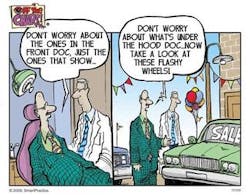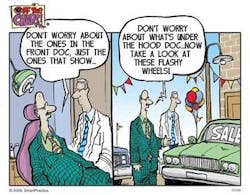Reader's Forum
Dear RDH:
I found Cindy Quinn’s article on the value of evidence-based practice (May 2009 RDH) to be excellent. She and I share a philosophy that dental hygiene care should be based on the best evidence for practices and product recommendations. Dental hygienists are scientists as we use science as a basis for our practice decisions, or we should be practicing with this goal. As a result, I quickly ordered Jane Forrest’s book, “Evidence-Based Decision Making,” and will read it thoroughly to assist me in finding properly designed studies for oral care outcomes.
Thank you for publishing this article and thank Cindy for her well-written insight into the concept of evidence-based dentistry.
Frieda A. Pickett, RDH, MS
Butler, Tennessee
Dear RDH:
Cindy Quinn’s article in this month’s RDH (May 2009 RDH) was terrific. This topic is critical for our professional growth. You are so right when you say that some dental hygenists live their professional lives under a rock.
Unless we adopt evidence-based decision-making (EBDM), we will never move forward as a profession. RNs are far ahead of us and their credentials mean something. They are committed to professionalism and EBDM. I sometimes look at their journals and it’s obvious that they are able to separate fact from fiction. Half truths are what disturb me most.
I’d love to see you present at RDH Under One Roof in the future on this particular topic. I also wish that we could have panels that debate issues at UOR. The debates would focus on EBDM and clinical guidellines. Many dental hygienists are hungry for this approach to discussions and that’s why I started the periotherapist group.
You’d be dynamite, Cindy! I’ve found that reputable companies applaud speakers who are well-versed in this particular subject, and it’s absolutely essential for us to be considered a “credible” source.
Lynne H. Slim, RDH, MS
Douglasville, Georgia
Dear RDH:
I am writing in response to an article that Colene House wrote in the December 2008 issue of RDH magazine. Her article was titled, “Monsters in the shadows.”
Her article tells of the devastating and crippling disease called carpometacarpal arthritis of the thumb that affects many dental hygienists in this country. I write to you today to tell you my story. I have been a full-time dental hygienist for 29 years and have been in the same practice for the last 23. I enjoyed my job and had a great relationship with the dentist I was working with. My plan was to retire when he did.
More than a year ago, I started having pain at the base of thumbs in both hands. It was especially painful in the left thumb. This surprised me because I thought the hand I used to scale with would be the worst. But, as Colene explained in her article, it is the constant gripping and pinching motion that causes the problem.
I was referred to an orthopedic surgeon who specializes in hands.
After speaking with me, he said, “I can tell you right now what your problem is. You have arthritis.”
I was shocked. After all, I was only 50 years old and I felt I was too young to have arthritis. Well, arthritis has no age barrier.
The doctor took X-rays of my hands, and, sure enough, there was the proof. He then said, “If you don’t stop doing what you are doing, I will be replacing your thumb joints in five years.”
I was stunned. I had carpal tunnel issues throughout the years, but this totally took me by surprise. I had not heard of this affecting hygienists. But after reading Colene’s article, I now understand that it is quite common.
I was not ready to stop work completely, so I reduced my work schedule by one day a week in the hope this would solve the problem. At first it was a great relief, but it did not last for long.
Less than a year later, I saw the orthopedic surgeon again, and we both agreed it was time for me to stop working. The pain had returned, and I was experiencing weakness like never before. My hands were screaming at me that they had had enough!
It was starting to affect my ability to do my job. I felt like I did not have the strength to scale properly. I was really, really slowing down, and it took everything I had to drag myself to work in the morning.
Now I would like to explain the silver lining of my story. Fortunately, I had purchased and maintained disability insurance for the last 26 years. Because I had done this, I was not affected financially by my loss of income. I have enough coverage to take care of myself until I turn age 65. My policy also allows me to work in another field if I choose.
But, I do not have to find another job because I am receiving as much from the insurance company now as I was when I was employed.
I wanted to tell my story to inform dental hygienists that you do have an option to protect your future.
Just think about this: What would you do if you couldn’t work anymore? How would you pay your bills?
I couldn’t take that chance 26 years ago and I am so glad that I purchased this insurance when those very questions were posed to me.
In conclusion, yes, definitely take care of yourself to avoid problems with your hands. Use the ultrasonic scaler when possible and use sharp instruments always, but remember my worst hand was the hand that held the mouth mirror. There is no way around not using a mirror. But most importantly, look into protecting your future by purchasing a good disability insurance policy. You will be so glad you did.
Jean Rockwell, RDH
San Diego, California
Dear RDH:
As a breast cancer survivor, I would like to acknowledge the awesome support demonstrated in central Oregon for oral health awareness and breast cancer patients. The collaborative donations from Brad Braman, DMD, Sisters, OR; CariesFree Inc., Albany, OR; and Hu-Friedy Inc., Chicago, have provided an opportunity to support prevention and full-body health.
Thank you for the two-year supply of helpful products and educational materials donated to the Sara Fisher Breast Cancer Project.
Uriel Fox, RDH
Sisters, Oregon
Correction
The May 2009 issue of RDH published an article titled, “To polish or not to polish,” by Stephanie Wall, RDH. The article was continued from one page to another, and the transition resulted in the deletion of approximately 250 words. Many readers were undoubtedly confused by the discussion of a Premier Dental product blending in with information about xylitol products.
We encourage readers to read the entire version of the article at www.rdh-mag.com. Our advice is to search for “wall + polishing”.
In addition, the article said the Enamel Pro prophy paste is a “two-phase delivery system to keep the calcium and phosphorous components from reacting with each other before use.” Premier Dental’s manufacturing process actually stabilizes the calcium and phosphate salts in the product until activated in the saliva. We regret the errors.

